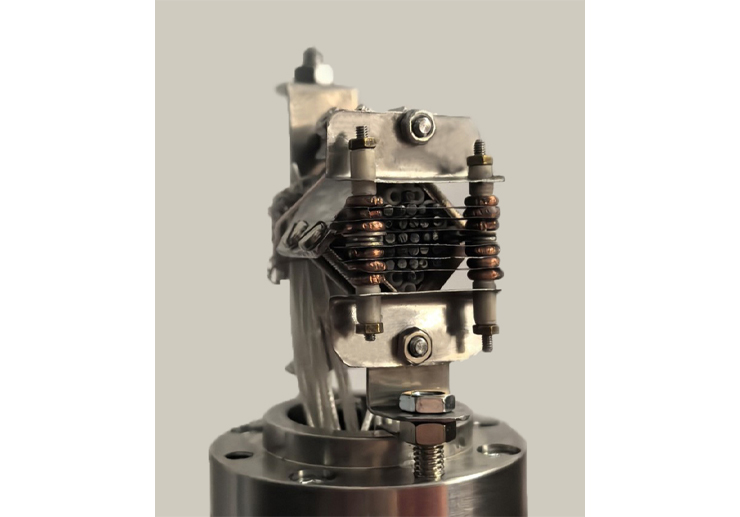FLNR JINR designed device for GASSOL Separator optimisation
News, 25 February 2025
Scientists at the Flerov Laboratory of Nuclear Reactions at JINR created and tested a sensitive beam profilometer to be used at the entrance of the GASSOL Gas-Filled Solenoid during its commissioning and adjustment. The new device is designed to control ion beam position, scale, and intensity in real time. The operability of the entire experimental facility will depend on these key parameters. The simple design of the developed radioresistant device will make it possible to manufacture new meters based on it with a wide range of scale and number of cathodes for new experiments at various facilities.
 The profilometer created at FLNR JINR with a distance of 2.1 mm between the centres of the rods. The first model of the device after exposure to the beam
The profilometer created at FLNR JINR with a distance of 2.1 mm between the centres of the rods. The first model of the device after exposure to the beam
The GASSOL Magnetic Gas-Filled Separator is a new experimental facility being developed at FLNR JINR for effective studies of the chemical properties of short-lived superheavy elements. The separator’s key element is superconducting magnetic solenoid, which makes it possible to separate complete fusion reaction products from ions of the primary and scattered beam and background reactions. In the near future, the GASSOL Separator will be installed and launched in the DC-280 Cyclotron Experimental Hall.
A secondary electron emission detector is the most suitable for creating a beam profilometer. Compared to luminophore detectors, a device of this type has better sensitivity, linearity, radioresistance, and readout stability during long-term operation.
During an experiment using a 40Ar+4 ion beam at 4 MeV/nucleon, the JINR specialists determined that the lower sensitivity limit of the profilometer is around 0.001 particle nA. The upper limit was established by thermal calculations and resulted in 100 pnA and 80 pnA in meters with graphite and aluminium cathodes respectively.
Experimental studies did not reveal any degradation of structural elements exposed to the beam, which confirms the high radioresistance of the device in the given range of operating parameters. In a gas environment, the meter, in addition to recording the secondary emission current, can operate in parallel in the ionisation chamber mode, which leads to an increase in its sensitivity.
For more information about the study entitled “Beam profile measurement at the entrance of the Gas-Filled Solenoid (GASSOL)”, read preprint P13-2025-2, published by the JINR Publishing Department. The authors of the study are Semen Mitrofanov, Yuri Teterev, Alexey Krylov, Askar Issatov, Konstantin Timoshenko, and Yeldos Bolatkazyyev.